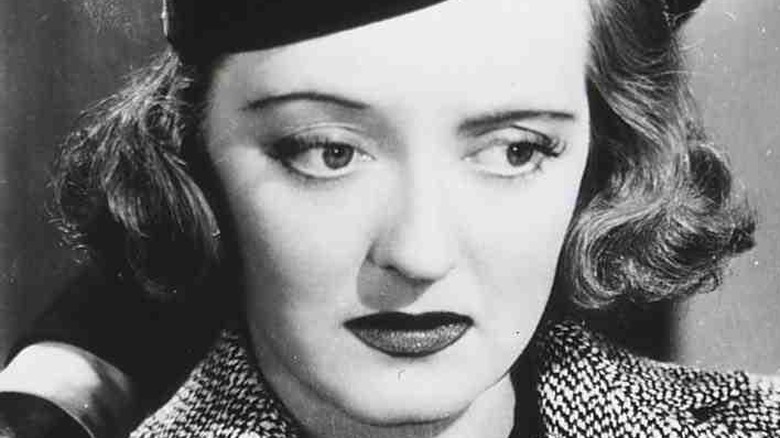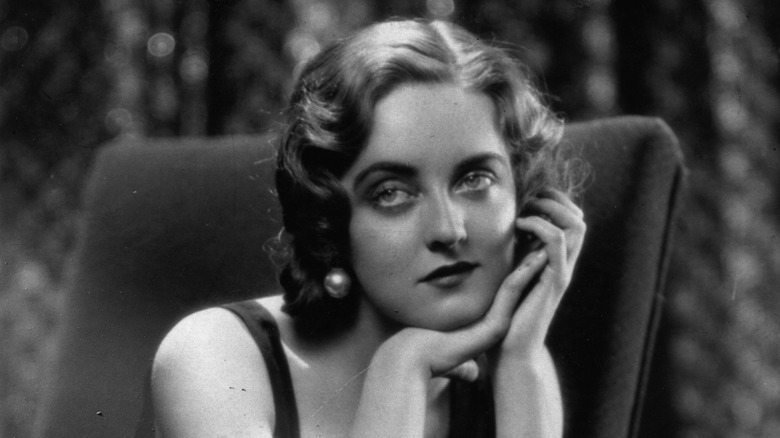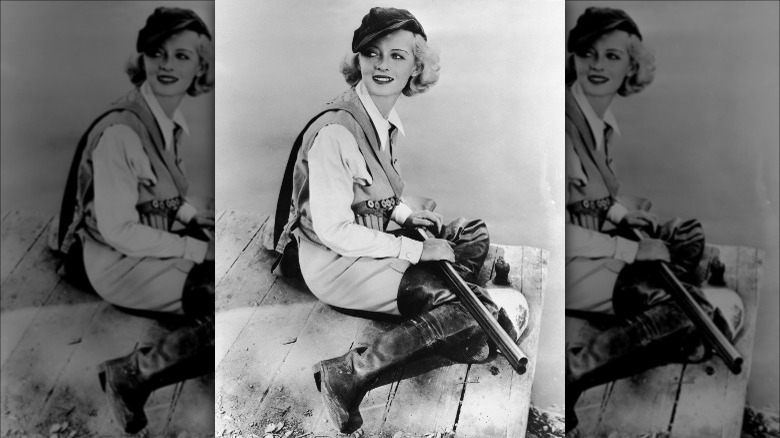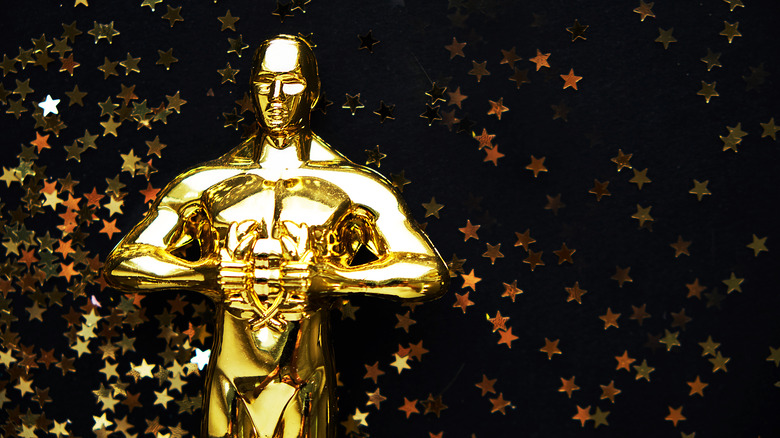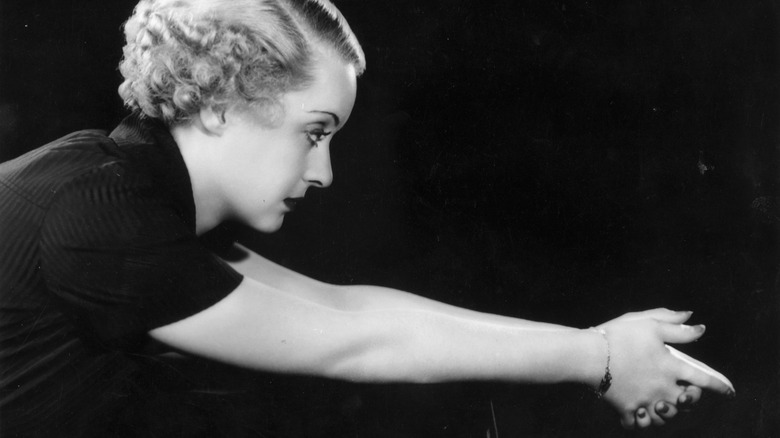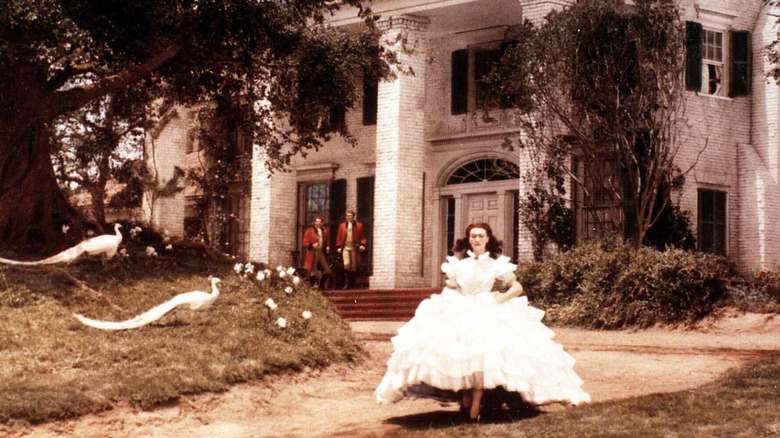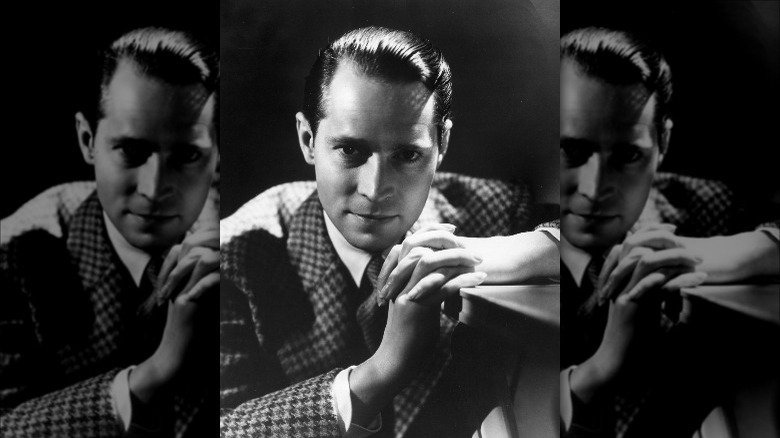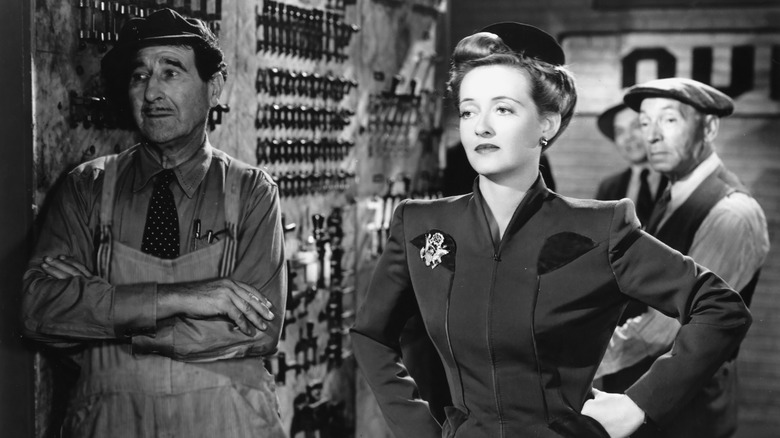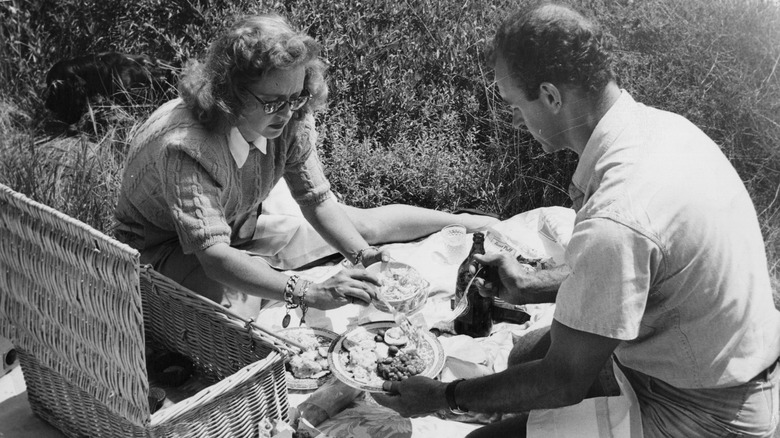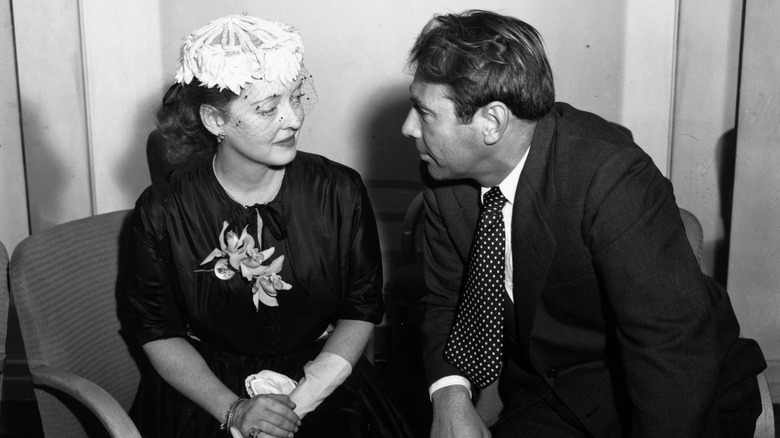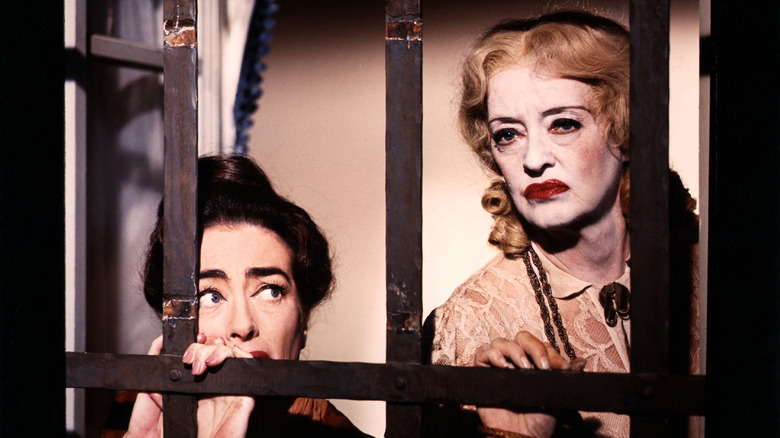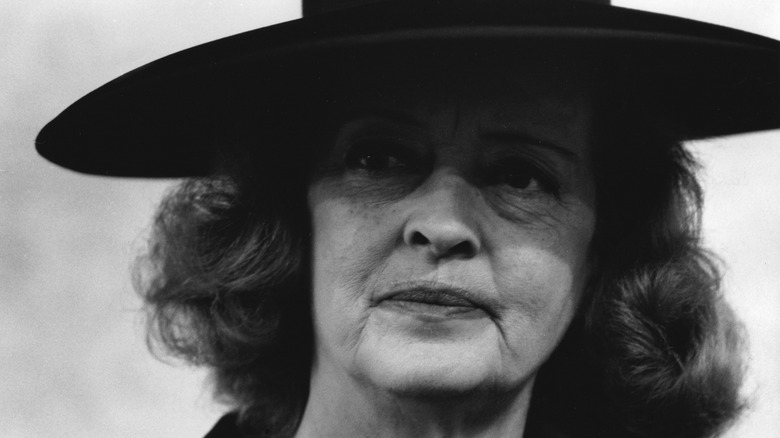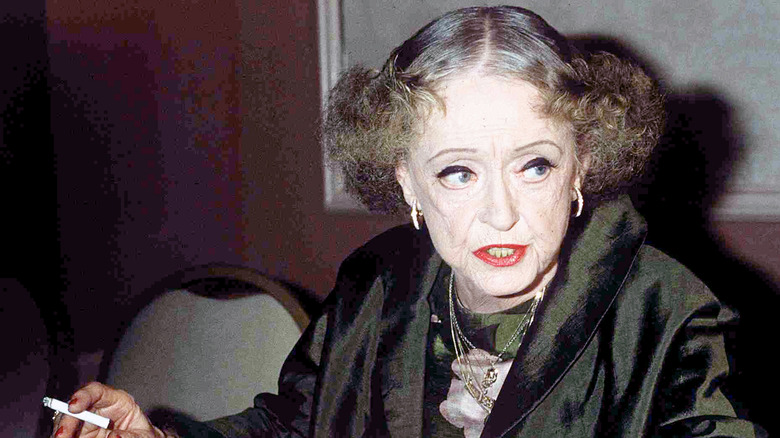The Untold Truth Of Bette Davis
"At her best, she is devastating ... at her worst, she is merely the best Bette Davis caricature out of all the other stars doing Bette Davis caricatures." So said the critic Rex Reed in 1968, by which time Davis was a renowned Hollywood legend whose idiosyncrasies were such that she was in danger of becoming a parody of herself.
But the future icon — who was also well-respected in her own lifetime as a campaigner for war veterans, earning a Distinguished Civilian Service Medal for her work with the Hollywood Canteen (via Biography) — didn't have an easy route to Hollywood stardom. Things didn't get much easier once she got there, either.
According to Bette Davis' memoir "The Lonely Life," the birth of her acting ambitions can be traced to a single evening in 1926, when she was just 18. Davis' mother, Ruthie, took her and her sister Bobby to see Henrik Ibsen's play "The Wild Duck." It was her first taste of serious theater, and the character of the daughter Hedvig so moved her that she "lost herself" in her experience, just as the actress portraying her, Peg Entwistle, seemed to. Davis was so affected by Entwistle's performance that she immediately told Ruthie that she wanted to become an actress. But while Ruthie was supportive, Davis' father, Harlow, wasn't. Davis was bent on proving her father wrong, setting her on a path to become one of Hollywood's most legendary battlers.
Her early screen tests were harrowing
Ruthie's first step was to take Bette Davis to New York, where she interviewed for a place at the prestigious theater school run by Eva Le Gallienne, but after what Davis described as a "defensive" performance during the interview, she was rejected as not exhibiting the required seriousness to join the school.
Davis eventually made it through several theater productions to begin screen testing at various Hollywood studios, but this was just the start of several fresh humiliations. After one screen test she was rejected because one of her teeth was crooked, after which she wore braces. Another screen test involved her hitching her skirt higher and higher, so the studio could see she was not hiding "some deformity." Davis later wrote that the resulting test footage was horrifying. "When I saw the test I let out a blood-curdling scream and ran from the projection room ... I was not aware that the camera had turned continuously while I was in front of it, and I had mugged horribly between shots of my sample emotions" (via "Mother Goddam").
At another, Davis was given no script, but told simply to lie on a couch, so that scores of male actors could be tested kissing her, an experience the young actress found excruciating. Nevertheless, she soon established herself in Hollywood, taking roles in six movies for Universal Pictures before signing a seven-year contract with Warner Bros. in 1932.
Davis wasn't considered beautiful
It may be unthinkable today, but the actress whose allure was celebrated in the Grammy Award-winning song "Bette Davis Eyes" by Kim Carnes in 1981 wasn't considered a screen beauty in her Hollywood heyday. As Davis recalls in "The Lonely Life," the early days of her career were plagued by concerns from studio executives, such as Universal Pictures founder Carl Laemmle, that Davis was not suitable to play a romantic lead. "The kid might be all right in certain roles but what audience would ever believe that the hero would to get her at the fade-out?" he is reported to have said. According to Davis, cameraman Karl Freund fought for her, telling Laemmle that Davis had "lovely eyes."
Davis nevertheless exploited her seemingly unusual look to great effect, by branching out to take various roles that typical leading ladies would not. Her first major film role as the repellent female antagonist Mildred in the 1934 film "Of Human Bondage" saw Davis become a critical darling, and her performance was later hailed by Life magazine as "probably the best performance ever recorded on the screen by a U.S. actress" (via "Mother Goddam"). Davis was already on her way to becoming Hollywood royalty.
Davis claimed she coined the Oscars
Although "Of Human Bondage" made Bette Davis into a breakout star on the silver screen and earned her an Oscar nomination, the critical plaudits and audience reception didn't translate into prizes when award season came around. It was only with her follow-up, 1935's "Dangerous," that Davis' talents were finally recognized by the Academy of Motion Picture Arts and Sciences. According to James Spada's "More than a Woman," his 1994 biography of Davis, the actress' win is believed to have been motivated by Academy members feeling that Davis has been snubbed in her earlier role. It didn't matter. For Davis, years of hard work had finally paid off.
In a gushing review, the critic E. Arnot Robertson declared: "I think Bette Davis would have been burned as a witch if she had lived two or three hundred years ago. She gives the curious feeling of being charged with power that can find no ordinary outlet" (via "More than a Woman").
And Davis' win might have another reason for going down in cinema history: per the same source, Davis claimed that it was she who came up with the affectionate name "Oscar" for the famous gold statuette after noticing a physical resemblance between the figure's posterior and that of her first husband, Harmon Oscar Nelson. (The Academy has never confirmed this as the source of the nickname.)
Davis was sued by her own studio
Though Davis was enjoying success as part of Warner Bros. Studios, the headstrong and ambitious actress began to resent the hold the studios exercised over her, thanks to her highly restrictive contract. As the 1930s rolled on, Davis became increasingly concerned with the lack of quality roles that were being offered to her by executive Jack Warner. According to James Spada, writing in "More than a Woman," things were looking up for Davis when she was cast in an adaptation of the play "The Petrified Forest," alongside Humphrey Bogart and Lesley Howard. But though she was initially enthusiastic about the cast and production, her role once again proved to be yet another female bit part. When the same frustrations emerged with the productions "The Golden Arrow," "Satan Met a Lady," and "God's Country and the Woman," Davis accepted work in the United Kingdom, which was against the terms of her contract.
In 1936, Warner Brothers sued their wayward star through the British courts. The subsequent trial drained Davis and heaped pressure on her relationship with her husband, Harmon Oscar Nelson. In the courtroom, Davis' claims that her contract amounted to "slavery" were ridiculed by Warner lawyers, who described Davis as "rather a naughty young lady." Davis lost the case, and was forced to return to the U.S. and resume her work with Warner Bros. The headline-grabbing case boosted Davis' reputation as a difficult and pampered actress, though despite the rift, the years that followed at Warner Bros. would be some of the most successful of her career.
Davis regretted not being in 'Gone With the Wind'
According to Bette Davis' official website, upon her return to the U.S. Warner Bros., perhaps buoyed by the incredible press coverage that the British court case had attracted, decided to reward the Oscar-winning actress with a better contract and to ensure that she was given the roles that were worthy of her burgeoning talent and on-screen magnetism. In 1938, Davis took the leading role as a Southern belle in "Jezebel," a performance for which she earned her second Academy Award. (She would go on to be nominated an incredible 11 times, though this would be the last of her long career.)
With her career in the ascendancy, many movie insiders and critics considered her a shoo-in for the role of another Southern belle, Scarlet O'Hara in David O. Selznick's upcoming "Gone with the Wind." The production was already highly anticipated after the success of the 1936 Margaret Mitchell novel on which the film was based.
According to "The Lonely Life," Davis made her interest in the role well known, saying the role "could have been written for me." Warner Bros. offered to lend Davis to MGM, the studio producing "Gone With the Wind," but insisted that the role of O'Hara's love interest Rhett Butler be played by another of their actors, Errol Flynn. However, Davis refused to play opposite Flynn, as she didn't rate him particularly highly as an actor, and the deal fell through. Nevertheless, Davis believe it was "insanity" that she never portrayed O'Hara in what is now considered one of the greatest movies of all time.
Bette Davis mixed business and pleasure
Though Bette Davis' career was going from strength to strength, her marriage to Harmon Nelson was falling apart, leading Davis to embark on a number of extramarital affairs with colleagues and co-stars on Hollywood shoots. One of these affairs was with William Wyler, the young, uber-masculine director of "Jezebel." According to James Spada, though Davis' relationship with Nelson was beginning to disintegrate and her relationship with Wyler could be tempestuous in the extreme, the time she spent with Wyler was among the happiest of her life.
On the set of the 1935 movie "Dangerous," Davis also began an affair with her co-star Franchot Tone (pictured), a meticulously handsome and suave leading man who was famous for his charisma and a long list of sexual conquests. And while the affair did not last longer than the time the two spent filming — members of the crew were well aware of the liaison — it was complicated by the fact that Tone was due to marry Joan Crawford, a hugely popular Hollywood star who later became Davis' great rival.
Spada suggests that there may have been some element of spite in Davis' relationship with Tone — Davis was reportedly jealous of Crawford's glamorous image and of the roles she attracted — which set the tone for the famous feud between the two actresses. Nelson filed for divorce from Davis in 1938.
Her behavior could be erratic
Bette Davis had a reputation for being a "difficult" actress, while her admirers argue that she was simply an overt perfectionist with a passion for making the best films she possibly could. Directors like William Wyler had such success with Davis because they matched her in ambition and could also match her in the demands they made.
But tragedy caused Davis to become more unreasonable on set than ever before. In January 1941, Hollywood watchers were shocked by the announcement that Davis had married 34-year-old Arthur Farnsworth, the manager of a New Hampshire lodge where Davis vacationed. The two enjoyed a calm and loving marriage until 1943, when Farnsworth died suddenly, the result of an undiagnosed blood clot.
The shocking loss hit Davis badly, affecting her behavior on set and leading her to act more aggressively and erratically than ever before. In "The Lonely Life" Davis admits, "In these years I made many enemies. I was a legendary terror ... When I was my most unhappy I lashed out rather than whined."
She had a tumultuous third marriage
Bette Davis' third marriage came in 1945, and as with her two previous marriages — to an unsuccessful musician and humble landlord — she wasn't marrying into greater fame. Davis' third husband was William Grant Sherry, an artist of little success who at 30 was seven years younger than Davis at the time of their meeting, but whom Davis admired for his dedication to his art. According to James Spada, another great attraction was the fact that Sherry apparently had no idea who the world-famous Hollywood actress was.
The two enjoyed a whirlwind romance, and Sherry, despite his precarious financial situation, soon proposed. Several of Davis' family and friends reportedly suspected that Sherry was exaggerating his attraction to Davis to get her fortune.
In 1947, Davis gave birth to a daughter, Barbara "B.D." Davis. It was the only year of the entire 1940s that Davis did not star in a movie, according to Stacker. However, though she attempted to balance work and motherhood, her marriage to Sherry was turning out not to be the blissful union that Davis had envisioned. The two fought endlessly, even on their honeymoon, when Sherry threw a case at Davis after a blazing argument, according to Hollywood historian Daniel Bubbeo. "I was unhappy from the first day," Davis said. They divorced after five years together.
Her fourth marriage was tragic
Bette Davis was married for the fourth and final time to Gary Merrill, the actor who had starred alongside her in the warmly received "All About Eve" in 1950. The role of acid-tongued thespian Margot Channing, who is finding her authority undermined by the appearance of a fresh-faced young actress, was uniquely appealing to Davis, and she adored the character to such a degree that when she and Merrill adopted a baby girl together in 1951, it was the name she chose for the child. The following year, they adopted a baby boy, Michael.
But while Davis's marriage to Merrill was the longest of her life — they divorced in 1960, after a decade together — it was also beset by tragedy. According to James Spada, as Margot grew, her parents became concerned about her unusual behavior. Upon examination, experts concluded that the child had suffered from brain damage, perhaps as a result of birth.
Davis and Merrill rowed violently over what they should do. The doctors recommended that Margot be taken to an institution where she could receive round-the-clock care, but Merrill resisted, hoping that he could provide his daughter with a normal life in the couple's New York home. Eventually, Merrill was convinced, and Margot was enrolled at the Lochland School, a facility where she would remain for the rest of her life.
A sexually charged feud
Bette Davis portrays an aging former child star who torments and abuses her disabled former movie star sister, played by Joan Crawford, in the 1962 film "What Ever Happened to Baby Jane?" It's become one of the best-remembered works of Davis' career. So revered is "Baby Jane" that in 2021 it was one of the 25 films selected for inclusion in the National Film Registry by the Library of Congress.
But the movie is also notorious for being the set on which the lifelong feud between its two stars played out. The pair had history: Just as Davis had pursued a romance with Crawford's fiancé Franchot Tone, Crawford had (unsuccessfully) attempted to solicit an affair with Davis' third husband, William Sherry (via "More than a Woman"). The two were in a constant game of one-upmanship with it came to Academy Award nominations. On the set of "Baby Jane," the epic feud reached new levels of spite, with Davis reportedly becoming physical during takes in which her character is meant to hit Crawford's. Davis denied she intentionally hurt her counterpart, but Crawford is said to have intentionally weighted herself down during a scene in which Davis drags her across the floor, to aggravate Davis' back problems.
However, in 2017 a new book written by Davis' assistant Kathryn Sermak forwarded the theory that their feud was charged with sexual tension: that Crawford in fact had a huge crush on Davis, and that from her side, at least, it was more of a love-hate relationship than a purely hateful one (via Vanity Fair).
Bette Davis: viral marketing pioneer
When filming wrapped on "What Ever Happened to Baby Jane?" in 1962, 54-year-old Bette Davis pulled a publicity stunt that would go down in Hollywood legend as perhaps an early example of immaculately pitched viral marketing. According to Snopes, the actress, who was growing impatient with the lack of roles afforded to middle-aged women in the film industry, published a classified ad in the Hollywood Reporter, which, under the title "Situation Wanted, Women" and alongside a classic Davis headshot read:
"Mother of three — 10, 11 & 15 — divorcée. American. Thirty years experience as an actress in motion pictures. Mobile still and more affable than rumor would have it. Wants steady employment in Hollywood. (Has had Broadway.) Bette Davis, c/o Martin Baum, G. A. C. References upon request."
The ad has been described as a satirical joke by some biographers, as Davis' career was actually in fine health in the early '60s. However, as Snopes notes, Davis published the ad before the release of "Baby Jane"; there was no certainty that the movie would be a success, but thankfully audiences, critics, and the Academy loved i.; Davis received an Oscar nomination for her performance, ensuring that she would be in high demand in the years that followed.
A fighter to the last
As Bette Davis entered old age, her reputation for toughness and her uncompromising character continued to precede her. According to Stacker, in the early 1980s Davis suffered severe health problems, including cancer and a stroke, while she also underwent surgery for a hip replacement. Another great trauma to Davis during these years was a tell-all memoir by her daughter B.D., titled "My Mother's Keeper." Published in 1985, the book painted Davis as spiteful and controlling, and shocked many of the actresses fans with its revelations. Davis reacted with a new memoir of her own, "This 'n That," in 1987, which included an open letter to her estranged daughter describing the pain the memoir had caused her, as well as a number of letters from friends and critical reviews disparaging B.D.'s book. Davis' supporters suggested that "My Mother's Keeper" was nothing more than a cynical "cash-in."
Nevertheless, the Davis staged a comeback, and continued to work into her ninth decade. In 1989, her cancer returned, and she died in Neuilly-sur-Seine, France, on October 9, at the age of 81. At Davis' request, her grave in Los Angeles carries an epitaph that sums up her life and career: "she did it the hard way."
